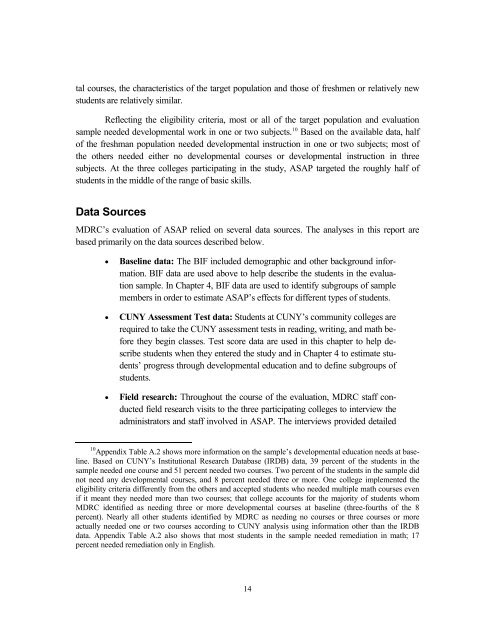1dOprzL
1dOprzL
1dOprzL
Create successful ePaper yourself
Turn your PDF publications into a flip-book with our unique Google optimized e-Paper software.
tal courses, the characteristics of the target population and those of freshmen or relatively newstudents are relatively similar.Reflecting the eligibility criteria, most or all of the target population and evaluationsample needed developmental work in one or two subjects. 10 Based on the available data, halfof the freshman population needed developmental instruction in one or two subjects; most ofthe others needed either no developmental courses or developmental instruction in threesubjects. At the three colleges participating in the study, ASAP targeted the roughly half ofstudents in the middle of the range of basic skills.Data SourcesMDRC’s evaluation of ASAP relied on several data sources. The analyses in this report arebased primarily on the data sources described below.• Baseline data: The BIF included demographic and other background information.BIF data are used above to help describe the students in the evaluationsample. In Chapter 4, BIF data are used to identify subgroups of samplemembers in order to estimate ASAP’s effects for different types of students.• CUNY Assessment Test data: Students at CUNY’s community colleges arerequired to take the CUNY assessment tests in reading, writing, and math beforethey begin classes. Test score data are used in this chapter to help describestudents when they entered the study and in Chapter 4 to estimate students’progress through developmental education and to define subgroups ofstudents.• Field research: Throughout the course of the evaluation, MDRC staff conductedfield research visits to the three participating colleges to interview theadministrators and staff involved in ASAP. The interviews provided detailed10 Appendix Table A.2 shows more information on the sample’s developmental education needs at baseline.Based on CUNY’s Institutional Research Database (IRDB) data, 39 percent of the students in thesample needed one course and 51 percent needed two courses. Two percent of the students in the sample didnot need any developmental courses, and 8 percent needed three or more. One college implemented theeligibility criteria differently from the others and accepted students who needed multiple math courses evenif it meant they needed more than two courses; that college accounts for the majority of students whomMDRC identified as needing three or more developmental courses at baseline (three-fourths of the 8percent). Nearly all other students identified by MDRC as needing no courses or three courses or moreactually needed one or two courses according to CUNY analysis using information other than the IRDBdata. Appendix Table A.2 also shows that most students in the sample needed remediation in math; 17percent needed remediation only in English.14


